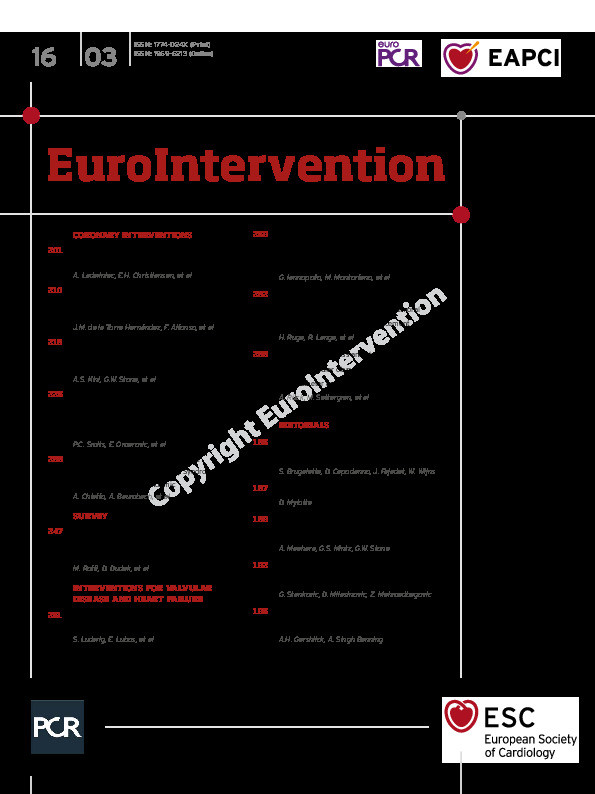
Compared to angiographic guidance alone, intravascular ultrasound (IVUS) improves clinical outcomes in patients undergoing percutaneous coronary intervention (PCI) because IVUS provides superior information regarding 1) the necessity of adjunctive lesion preparation; 2) optimal device sizing to achieve the largest minimum stent area (MSA), the strongest predictor of future events; 3) appropriate stent length to cover the entire lesion and avoid geographic miss; 4) stent underexpansion or residual disease at the stent edge requiring further treatment; and 5) acute complications including stent edge dissection/haematoma or stent deformation. The benefits of IVUS guidance on clinical outcomes are most pronounced when treating high-risk lesions or patients – especially those with unprotected left main coronary artery (LMCA) disease in whom emerging evidence suggests a mortality advantage. This was most recently noted in a report from the British Cardiovascular Intervention Society (BCIS) in which 50% of LMCA PCI procedures in the UK were guided by imaging, a practice which was associated with a one-year 34% mortality reduction1.
In a substudy of the multicentre randomised NOBLE trial (drug-eluting stents [DES] vs bypass surgery in patients with LMCA disease) published in this issue of EuroIntervention, Ladwiniec and colleagues report that IVUS guidance was used in 72% of PCIs and was associated with a reduction in LMCA-related revascularisation2.
A larger final MSA was negatively associated with LMCA-related revascularisation, although post-PCI IVUS was available in only 224 (~one third) of the PCI cohort. The LMCA MSA measured 12.5±3.0 mm2 in the IVUS substudy of NOBLE, much larger than in EXCEL (another randomised trial of DES vs bypass surgery in LMCA disease) in which the LMCA MSA measured 9.9±2.3 mm2 in 505 patients (Maehara A. IVUS-guided Left Main and Non-left Main Stenting in the EXCEL Trial: Lessons From the EXCEL IVUS Core Laboratory. Presented at TCT 2016, Washington, DC, USA, 31 October 2016) or in a single-centre Korean study where the LMCA MSA measured 10.2±2.4 mm2 in 403 patients3, even though all three cohorts had similar LMCA complexity. The IVUS substudy of NOBLE reconfirmed that IVUS guidance improves clinical outcomes, probably indicating to the operator how to achieve a larger MSA wisely. However, because a specific IVUS optimisation protocol was not pre-specified, it may be difficult to generalise these findings.
In a complementary study also published in this issue of EuroIntervention, de la Torre Hernández and colleagues provide novel insights regarding the use of a standardised IVUS-guided stent optimisation protocol when treating LMCA lesions4.
They compared 124 patients treated using this pre-specified protocol versus two propensity-matched cohorts: (1) IVUS guidance without a pre-specified protocol (n=124), and (2) angiography guidance alone (n=124). Patients treated with the pre-specified protocol achieved stent expansion optimisation in 88% versus 65% after IVUS guidance without a protocol; the LMCA median MSA measured 11.8 (10.2-12.6) vs 10.0 (8.1-11.2) mm2, respectively, a substantial difference. Compared to angiography guidance, the IVUS protocol group had better clinical outcomes. However, the protocol did not specify how to choose the device based on pre-PCI IVUS. Also, the protocol may be difficult for some interventional cardiologists to follow, emphasising the importance of training and education.
What questions remain regarding LMCA PCI imaging guidance?
First, does a small LMCA MSA always indicate stent underexpansion? A smaller final MSA may be attributable to small vessel size and does not always represent stent underexpansion. In these patients, maximal possible achievable stent expansion may be especially important. Thus, pre-intervention IVUS evaluation is important to clarify vessel area as well as the best individualised approach to optimise MSA, especially in small LMCAs.
Second, can imaging help to identify specific distal LMCA lesions requiring a two-stent technique versus the often preferred provisional stent strategy? Bail-out implantation of a second stent is necessary in 9.7-47% of LMCA bifurcation lesions attempted with a single-stent provisional approach and may predict a higher rate of target lesion revascularisation of the left circumflex (LCX) ostium versus an elective two-stent technique or a successful single-stent crossover procedure5. Identification of lesions that are likely to require a stent in the LCX would thus enhance procedural planning and efficiency. Angiographic criteria for a two-stent technique as evaluated by Chen et al included angiographic severity and localisation of lumen stenosis in the bifurcation along with the bifurcation angle6. We reported that ~90% of distal LMCA plaques extend into the proximal left anterior descending artery (LAD) regardless of angiographic appearance7. However, when the LCX ostium was free of disease confirmed by IVUS, crossover stenting from the LAD to the LMCA rarely resulted in functional LCX compromise8. IVUS-derived criteria should guide the decision to plan implantation of one versus two stents versus angiographic criteria more accurately.
Third, can we improve the quality of stent implantation by visualising guidewire positioning and, if necessary, repositioning the guidewire into the LCX? Among 127 patients treated with two stents in the EXCEL IVUS substudy, eccentric guidewire positioning and subsequent ballooning that relocated the struts into the side branch caused a gap at the carina in 11%. This may be answered in the ongoing OCTOBER trial in true bifurcation (including LMCA) lesions in which a pre-specified optical coherence tomography guidance protocol requires repositioning the side branch guidewire if the crossing point is suboptimal9.
Finally, should all LMCA procedures be IVUS guided or is there a threshold of PCI experience which mitigates the benefits of IVUS? We believe not. In the BCIS analysis the greatest benefit of imaging guidance was seen in the hands of interventional cardiologists with the greatest PCI experience1. We suspect that the most experienced interventionalists were also the ones most knowledgeable in how to use intravascular imaging to optimise their procedures. Thus, the only way to develop and maintain an “IVUS eye” is to keep using IVUS, especially during LMCA interventions where there is no room for error.
Conflict of interest statement
A. Maehara reports research grant and consultant fees from Boston Scientific and Abbott Vascular. G. Mintz reports speaker honoraria from Terumo, Philips, Boston Scientific and Medtronic. G. Stone reports speaker or other honoraria from Cook, Terumo, Qool Therapeutics and Orchestra Biomed; he is a consultant to Valfix, TherOx, Vascular Dynamics, Robocath, HeartFlow, Gore, Ablative Solutions, Miracor, Neovasc, V-Wave, Abiomed, Ancora, MAIA Pharmaceuticals, Vectorious, Reva and Matrizyme; and holds equity/options from Ancora, Qool Therapeutics, Cagent, Applied Therapeutics, Biostar family of funds, SpectraWave, Orchestra Biomed, Aria, Cardiac Success, MedFocus family of funds and Valfix.
Supplementary data
To read the full content of this article, please download the PDF.

